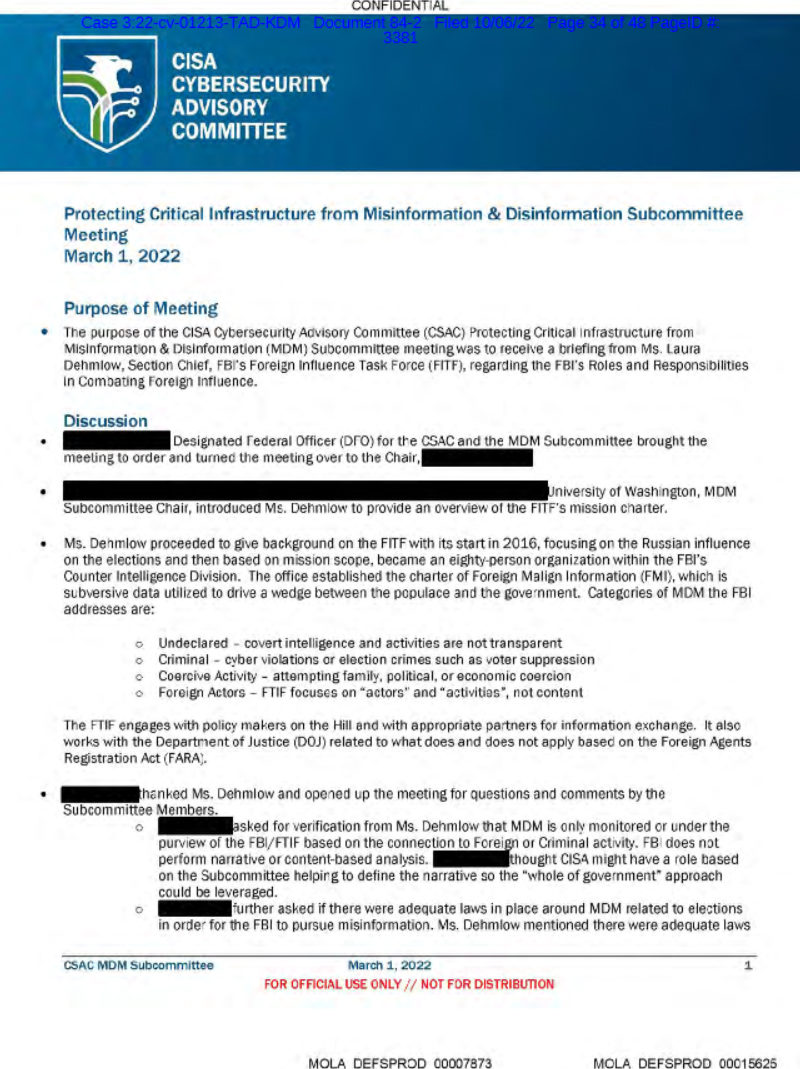Leaked files show DHS “Ministry of Truth” lives on in secret
More worryingly, the files also show that this board never died; it was just rebranded and lives on. This effort will be outsourced to cutouts and sham NGOs and non-profits as to “avoid the appearance of government propaganda.”
Kit Klarenberg, MPN.news
On October 31, journalists Lee Fang and Ken Klippenstein released a trove of leaked documents exposing how, in recent years, the Department of Homeland Security’s (DHS) desire – and ability – to curb speech in both online and offline realms has ramped up significantly.
Along the way, a government department ostensibly founded to defend Americans from terrorist violence has become the single biggest threat to free speech in the U.S. What is more, the DHS is being actively abetted in this malign mission by major tech firms.
These papers show that officials at the highest levels of the Department are maneuvering to establish a decisive stranglehold over the flow of information in news outlets and on social media platforms, while covertly co-opting and infiltrating civil society groups as “clearing houses” for government propaganda, and consistently deceiving Americans as to their true intentions.
Furthermore, they are preparing to deploy invasive technology developed by Israeli special forces to spy on the opinions and utterances of everyday citizens – and may well already be doing so.
With the specter of “disinformation” being talked up almost daily as a dire threat to public health and safety, and definitions of the supposed phenomenon shifting constantly according to political need, there is no telling who could be branded an enemy of the state, and subject to surveillance, harassment, censorship, or worse, as a result of this dangerous shift.
The most explosive documents relate to the highly controversial DHS Disinformation Government Board’s (DGB) germination, and its continuation via other means following purported closure.
The Board’s launch in April this year was met with much mainstream hullabaloo. Corporate journalists, think tank pundits and government officials alike hailed the initiative as a groundbreaking innovation in the battle against domestic and foreign-borne “disinformation”, with fawning praise reserved for its chief Nina Jankowicz, a 33-year-old former Ukrainian government communications advisor.
However, clarity on the Board’s precise purpose, functions, budget and objectives was initially unforthcoming, greatly reinforcing already ample anxieties of individuals and organizations outside the media bubble. Substantive and vital concerns were raised by rights groups and dissident lawmakers about its constitutionality, and whether it would serve as a state censorship mechanism. Many comparisons were drawn with George Orwell’s nightmarish Ministry of Truth.
Jankowicz’s shameful history of defaming independent news outlets, such as The Grayzone, as “Russian disinformation”, crazed attacks on WikiLeaks and its jailed founder Julian Assange, eager advocacy of the fraudulent Trump-Russia dossier, and support for suppressing the New York Post’s fatual reporting on Hunter Biden’s emails, likewise handed critics abundant fodder.
Subsequent assurances from DHS officials that the Board would have no operational powers, but simply advise government departments on how to counter disinformation, did nothing to quell the disquiet. Such was the furor, the DGB was placed on indefinite “pause” by Department officials after just three weeks, then reportedly closed outright in August.
The leaked files make a mockery of the repeated insistence of DHS officials that the DGB wasn’t intended to actively dictate what’s true and false, or aggressively police the information citizens can and can’t be told, and by whom. And they strongly suggest the DGB’s public “shutdown” was pure subterfuge.
DHS JOINS FBI WAR ON “SUBVERSIVE DATA”
Among the documents are minutes of a March 1 meeting of the DHS Cybersecurity and Infrastructure Security Agency (CISA) Cybersecurity Advisory Committee, which has overall control of disinformation policy within the Department.
The Committee is composed of officials drawn from numerous government agencies and contractors – primarily in the tech sphere – as well as civil society actors. At the time, this included Twitter’s head of legal policy, trust and safety, Vijaya Gadde, University of Washington professor Kate Starbird, and a J.P. Morgan executive whose name has been redacted.
The Committee met to be briefed by FBI Foreign Influence Task Force chief Laura Dehmlow, “regarding the FBI’s roles and responsibilities in combating foreign influence,” in advance of the DGB’s formation eight weeks later. The minutes speak to a determination on the part of attendees to significantly expand the scale and influence of DHS counter-disinformation efforts, with almost every representative making an active contribution to discussions at some stage.
Dehmlow kicked off proceedings by explaining the work of her Task Force, which was established in 2016 to counteract “Russian influence” in that year’s Presidential election.

Rapidly, “based on mission scope,” the Task Force became an 80-person-strong dedicated component within the FBI’s counterintelligence division, and established a charter of “Foreign Malign Information,” which is defined as “subversive data utilized to drive a wedge between the populace and the government.” This is likely a euphemism for any information that could inspire distrust in the U.S. empire among its citizens at home.
Dehmlow added that her unit “does not perform narrative or content-based analysis,” prompting a participant – name redacted – to suggest CISA “might have a role based on the subcommittee helping to define the narrative so the whole of government approach could be leveraged.” Then followed a discussion between Committee members on “organizational information sharing between the public/private sector; how to collaborate across channels; driving resiliency building and education” about disinformation.
Ominously, “when asked to define a goal” for tackling disinformation, Dehmlow stated, “we need a media infrastructure that is held accountable.” While the senior Bureau operative acknowledged her Task Force “engages with policymakers on the Hill and appropriate partners for information exchange,” there was no mention of her existing, active role in holding major online platforms “accountable”.
Dehmlow is a named defendant in a May lawsuit brought against the Biden administration by the Attorney Generals of Louisiana and Missouri over allegations of government collusion with tech giants to censor inconvenient news reports. A recent court filing reveals she was “involved in communications between the FBI and Meta that led to Facebook’s suppression of the Hunter Biden laptop story.”
That connivance successfully – albeit temporarily – resulted in Facebook and Twitter banning the sharing of any and all links to online articles about or even referencing the laptop’s damning contents, in advance of the November 2020 Presidential election. This was justified on the fraudulent basis the story was a potential Russian information operation.
Other portions of the filing reference how Dehmlow was also intimately connected to ongoing efforts by her Task Force to compel “suppression of election-related speech” on other social networks, including LinkedIn, being “routinely included” in meetings related to “social media suppression” with company top brass.
In any event, at the meeting’s conclusion, attendees were asked for “additional comments with regards to the subcommittee’s way forward,” which led to a “series of questions”, the answers to which it was felt would help the DHS “move toward providing an approach or recommendation” for dealing with disinformation in conjunction with the FBI, being drawn up. Chief among them: “how do we get to push the envelope to obtain traction in this area?”
The answer to this bold, aspirational query was markedly unsophisticated. One participant – name redacted – suggested finding an organization that “has done appropriate social media monitoring for the government,” leading CISA’s Kim Wyman to cite a Stanford study recommending social media companies not promote disinformation peddlers, “in order to reduce the promulgation of information from these people.” Resultantly, Gadde ever so helpfully revealed that Twitter operated a “three strike system” to “de-amplify” such “bad actors.”
In sum, the subcommittee’s envelope-pushing, traction-obtaining grand vision was simply to identify social media users sharing the “wrong” things via a third party, then reporting offending accounts until they were eventually shadowbanned or permanently suspended.
Gadde was one of a great many Twitter staffers purged by the social network’s new owner, Elon Musk, after he took control in late October. It is unknown whether her enthusiastic collaboration with CISA played any role in her contract’s termination, or if she was simply victim of an indiscriminate mass defenestration of lavishly-remunerated executives.
Nonetheless, the leaked files show Gadde offered up a wealth of sensitive insider insight into how Twitter operates in respect of “disinformation”, illuminating several ways the DHS could weaponize the platform for its own ends, while pushing for the scope of the Department’s disinformation busting activities to be greatly increased.
CREATING COVERT NARRATIVE “CLEARING HOUSES”
Minutes of subsequent meetings show how CISA leaped on the DGB’s launch to broaden its own powers and purview, then replace the body after its ignominious collapse.
Initially, it was expected the Committee would act as the DGB’s operational wing, enforcing its directives and cracking down on the spread of particular stories and narratives via direct media and social media interventions.
Several discussions across April centered around optimal means of “[amplifying] trusted information,” and seeding “counter-narratives” to “disinformation” across the media, to ensure journalists proactively sang from the same hymn sheet should information or perspectives emerge that the government wished to conceal or discredit.
All along, Gadde took a leading role, variously suggesting “keeping the aperture of recommendations broad regarding media,” rather than “limiting recommendations to just social media,” and considering carefully “how many counter-narratives an organization can issue” per incident, to avoid muddying the waters too much.
She also disclosed that Twitter “evaluates the level of harm done in disinformation incidents,” although further elucidation – such as whether this is shared, or calculated, in conjunction with an external entity such as the DHS – was unforthcoming.
The solution, proposed by director of CISA’s Election Security Initiative Geoff Hale, was to outsource the work of battling disinformation to cutouts, using NGOs and nonprofits as a “clearing house” for “counter-narratives,” in order to “avoid the appearance of government propaganda.”
Another Committee member – name redacted – concurred that “designating multiple voices as the clearing house so there is not one trusted voice” was ideal, thereby creating the false illusion of unanimity across multiple ostensibly independent sources, when the ultimate origin of all these “counter-narrative” was the Department of Homeland Security.
Another core consideration was “pre-socializing” Committee’s work before and after launch, and “socializing” it after. This meant contacting rights groups and lawmakers to brief and acquaint them with the body’s activities in advance of it becoming public. Recommendations for conducting this PR offensive were distributed among the group in advance, with particular emphasis on how to answer difficult questions related to matters such as “surveillance and monitoring” of private citizens should they arise.
The DGB being placed on pause did nothing to halt these initiatives. In fact, lessons were learned from that debacle, with the list of entities to be brought onside with the Committee’s work, now it would be operating solo, extended to include rights groups such as the Electronic Freedom Foundation (EFF). The EFF prominently criticized the Board and demanded assurances from Homeland Security Secretary Alejandro Mayorkas that it not police speech, online or otherwise.
Other civil society organizations in the Committee’s crosshairs included the Brennan Center for Justice. Gadde added to the list, naming similar entities Twitter had partnered with in the past, “in the event the group would like to reach out to any additional individuals” – input offered despite angsting about her dual roles.
At one meeting, Gadde shared a “recent communication” she had sent to CISA director Jen Easterly “about her own involvement in the committee’s work given the fraught time, in advance of the election season.” She wasn’t alone; at the same summit, an unnamed participant similarly “expressed concern for the group’s efforts,” cautioning members “on how to communicate their ongoing work.”
Come June 22, the Committee had prepared a draft report for Easterly, on “protecting critical infrastructure from misinformation and disinformation.” It boldly called for CISA to approach these issues with “the entire information ecosystem in view, including social media platforms of all sizes, mainstream media, cable news, hyper partisan media, talk radio, and other online resources.”
“Where possible,” it added, CISA “should proactively provide informational resources – and assist partners in providing informational resources – to address anticipated threats,” while engaging in both “prebunking and debunking” of unwelcome narratives.
“Proactive work should also include identifying and supporting trusted, authoritative sources in specific communities,” the document advocated.
DHS PARTNERS WITH ISRAELI PRIVATE INTELLIGENCE FIRM
Clearly, then, the guarantees of DHS officials that the DGB wouldn’t play a role prowling the online sphere for individuals possessed of dangerous “wrongthink” and punishing them accordingly, were outright lies.
At the very least, while the Board itself may not have been designed to eventually exert “operational” powers, its CISA partner absolutely was from day one. That the Committee’s representatives are well-aware of how deeply disturbed the general public would be if their initiative’s true nature was openly advertised, and the urgent need to disguise this as a result, is starkly underlined in records of multiple meetings. Over and over again, for example, the topic of “social listening” – resources that track conversations online in real-time – is discussed.
While manifestly keen to adopt such strategies – which would result in direct state surveillance of citizens’ private and public communications, contrary to firm, repeated DHS assurances the DGB wouldn’t engage in such activities – Committee members felt it best to hold off on making any concrete “recommendations” in this regard. At one point, Gadde even “cautioned the group against pursuing any social listening recommendations” in formal, private discussions with CISA director Jen Easterly, regarding the group’s disinformation battling proposals.
At another meeting, a Committee member – name redacted – “stressed that this is the most sensitive recommendation and could overshadow other recommendations posed by the committee.” It was resolved instead to engage “a broader governing body such as Congress” before going further.
“Sensitive” the use of social listening tools by domestic intelligence agencies may be, but the DHS has access to and recently deployed far more intrusive technology. Earlier this month, Democratic Senator Ron Wyden released an internal DHS Office of Intelligence Analysis report that showed that, in 2020, the Department attempted to concoct a left-wing domestic terror threat, in order to help President Trump.
Following direct orders from the White House, acting Homeland Security Secretary Chad Wolf set DHS operatives on a quest to amass dossiers on residents of Portland, Oregon attending protests sparked by the police murder of George Floyd. Beyond mere spying, top officials were tasked with linking demonstrators to an imaginary terrorist plot, and fabricating evidence of financial ties between unconnected protesters in police custody.
As it was, the effort failed miserably, although hundreds if not thousands of private citizens were ensnared in the DHS dragnet. This included not just protesters, but their “friends and followers…as well as their interests,” up to and including “First Amendment speech activity.”
These dossiers were compiled using “social media aggregation tool” Tangles, which was created by Cobwebs, a company founded by former Israeli Occupation Force specialists that hawks big data, artificial intelligence and machine learning tools to foreign security and intelligence agencies. Widely used by U.S. law enforcement, its sales manager Johnmichael O’Hare was formerly Commander of the Hartford, Connecticut PD’s Vice, Intelligence, and Narcotics Division.
Evidently, the DHS has the power and capability to spy on – and criminalize – law-abiding citizens to a far greater extent than CISA is willing to overtly admit. As such, it is only reasonable to ask whether the DGB was intended to “socialize” publicly what its parent department has been doing clandestinely for some time.
Committee members were clearly thrilled by how the Board’s launch focused mainstream attention on the subject of “disinformation”, and the grave threat it purportedly poses to national and individual security. A May 10 meeting of the group began with CISA Senior Election Security Lead Kim Wyman hailing how “misinformation and disinformation are elevated to national awareness due to this Board.” The rest of the rendezvous was overwhelmingly concerned with ways to market the Committee accordingly.
It is uncertain the extent to which the blueprints for arm’s length state control of democratic spaces outlined in the June draft document have progressed since its publication, but the infrastructure underpinning that monstrous endeavor is unambiguously well-developed, and could be activated at any time. It may well be operating already, in the shadows.
As such, even if the damning disclosures of Fang and Klippenstein thwart the CISA anti-disinformation effort’s planned public rollout, it seems all but inevitable that it will simply be rebranded yet again, and its true nature better obscured via more effective “socializing” next time round.
Feature photo | Illustration by MintPress News
Kit Klarenberg is an investigative journalist and MintPresss News contributor exploring the role of intelligence services in shaping politics and perceptions. His work has previously appeared in The Cradle, Declassified UK, and Grayzone. Follow him on Twitter @KitKlarenberg.




